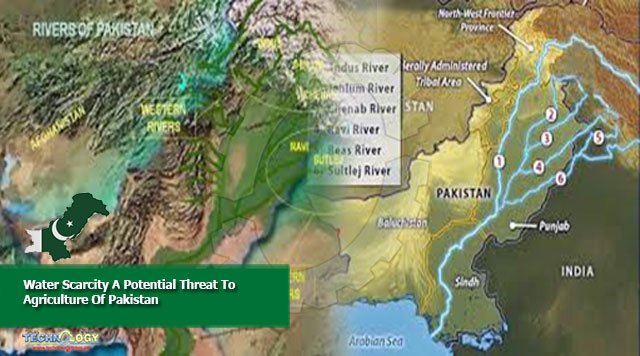Pakistan is a semi-arid region and principally its economy is agriculture dependent. Its water resources are not only limited but also exhaustible.

Authors: Yousuf Akram1, Dr. Zubair Aslam1, Muhammad Waqas1, Mehwish Nadeem1.
Pakistan has the world’s largest adjoining irrigation network in the form of canals, distributaries and water courses with its own natural benefits as well as operational and management problems. Pakistan’s agriculture depends mainlyupon irrigation and 90% of its agricultural output comes from irrigated lands. Out of 23.17 million hectares which is cropped area, 18.4 million hectares are irrigated by different sources. The Indus Basin irrigation system is the principal agriculture base of the country.
It is facing serious constraints and issues of environmental (climate change, drought), financial, political (Indus Water Treaty, etc.), policy-management, governance, and technical nature, and many others. Such issues are posing water security concerns and require extreme and imperativeawareness. There is a need to secure the available water potentials and develop additional potentials to improve water availability and storage for agricultural sustainability in the country.
The 21st Century has brought new challenges of diverse nature in several dimensions like problems in environmental and socio-economic sectors in Pakistan. The issues in the water sector are arising from not only due to increased demand of water supply for growing agricultural and domestic needs but also due to decreasing water availability. Pakistan’s water profile has changed drastically from being a water abundant country to one experiencing water stress. Exploitation of Indus Water Treaty (1960) by India through construction of dams on western rivers, excess water release during moon soon season in eastern rivers and restricting water supply in water scarcity period of the year is among the biggest issues related to water availability. Particularly these days India is under dominance of “Racist Modi” whose policies are totally based on “Anti Pakistan Drive”.
Simultaneously, the supply is hampered by its small water storage capacity and climatic changes that have made rainfall more erratic, leading to floods in some years and droughts in the others. Above all of these, the glaciers which are “Mothers of Rivers” are melting at a faster rate due to global warming which is the most alarming future threat.
Population growth, rapid urbanization, industrialization, as well as water-intensive obsolete farming practices contributed to Pakistan’s increasing demand for water. Flood irrigation, the prevailing system in the hot and semi-arid Pakistan, leads to heavy losses of water through evaporation and hence less water use efficiency.
Poor water infrastructure (Conveyance losses ranges from 25-40%) and inadequate lining of canals, along with breaching (sometime illegal) of water courses, further exacerbates the situation of water availability and supply. Water thefts by collusion of “Baildaars” with landlords along with the silting up of canals are causing no water supply to tail areas.
Excessive pumping of aquifers (potential groundwater reservoirs) has raised major concerns over irrigation system sustainability, as 3.41 million hectares are directly irrigated by tube-wells and about 8 million hectares are irrigated by canal cum tube-well system. Groundwater has been excessively exploited in the inter-fluvial areas of the Indus basin, causing its depletion both for irrigation and domestic purposes.
The government polices along with the political stability in the country also influence water sustainability. Unfortunately over last years, government did not realize the importance of this issue hence no major water storing project was started in last few years. And on international level case of Indus Water Treaty was not presented as it should be presented in front of world.
So, there should be emphasis on the fundamental importance of close connection between strategic planning, adaptation of sound policy, and quick and effective implementation.The concerned departments and policy makers should find the information and guidelines herein useful in evolving a strategy of effective water management which includesdividing the Indus Basin into agro-climatic zones and develop long-term water strategies and crop combinations for each zone, Improving agricultural practices and technologies to produce more crop per zone. Developing infrastructure and improving micro-irrigation techniques, aggressively promote water conservation, rehabilitate the freshwater-seawater interface on coasts which adapt to climate change.
Authors: Yousuf Akram1, Dr. Zubair Aslam1, Muhammad Waqas1, Mehwish Nadeem1. 1Department of Agronomy, University of Agriculture Faisalabad.
